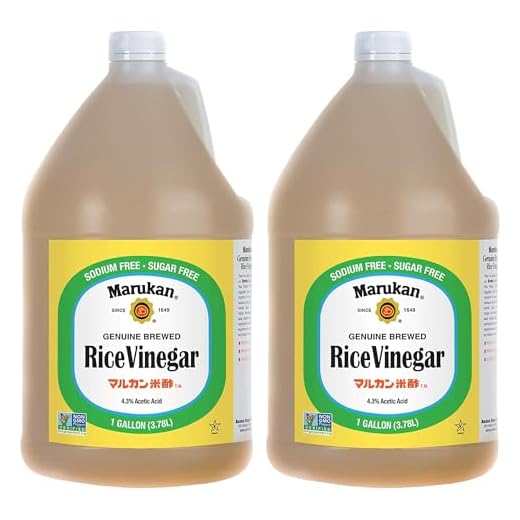

Using a different type of acidity can yield interesting results in your culinary creations. If you don’t have the specific sour liquid on hand, the alternative can work well, although the flavor profile will shift. The alternative is generally more robust, with deeper notes, while the original is milder and slightly sweeter.
When considering a swap, adjust the quantity to account for the stronger flavor of the alternative. Start with a smaller amount and taste as you go, ensuring the balance remains suitable for the dish. Additionally, incorporating a bit of sugar can help mimic the sweetness of the original, facilitating a smoother transition in flavor.
Experiment with this substitution in dressings, marinades, or dipping sauces where the acidity plays a pivotal role. The outcome may surprise you and lead to delightful new flavor combinations that elevate your dishes to new heights.
Using Alternatives for Rice-Based Acidity
Opting for a different type of acidity in recipes may yield satisfactory results. The flavor profile of a particular ingredient may not match perfectly, but the outcome can still be delightful. When choosing a substitute, aim for a balance of sweetness and tang. A highly recommended alternative is a blend of apple cider acidity with a touch of lemon juice. This combination provides a similar sharpness with a hint of sweetness, making it suitable for dressings and marinades.
Flavor Adjustments
If you find yourself in need of a substitute, consider adjusting your seasonings. Adding a pinch of sugar to your dish can help mimic the subtle sweetness found in rice-based acidity. Another effective method is incorporating a small amount of citrus juice, such as lime or lemon, which can enhance the overall flavor profile without overpowering the dish.
Usage Tips
When experimenting with alternatives, start with smaller quantities and gradually increase to suit your taste preferences. Each ingredient reacts differently, so it’s essential to taste as you go. Additionally, if you’re capturing moments of your culinary creations, a best compact digital camera with interchangeable lenses can help you document your experiments beautifully.
Flavor Profile Differences Between Red Wine Vinegar and Rice Vinegar
The complexity of these two acidic liquids lies in their distinct flavor profiles. The first type boasts a pronounced tartness complemented by fruity undertones, often reminiscent of dark berries and cherries. This depth lends itself well to robust dressings and marinades, enhancing heartier dishes like roasted meats or grilled vegetables.
In contrast, the second type presents a milder, sweeter taste with a hint of nuttiness. This gentle acidity makes it ideal for delicate salads, sushi, and light Asian cuisine. Its subtle flavor allows it to blend seamlessly without overpowering other ingredients.
Usage Considerations
When selecting between these two, consider the dish’s overall flavor balance. For bold and rich recipes, opt for the first variant to elevate the dish’s profile. However, if the goal is to maintain a light and fresh taste, the second variant is preferable. Always remember that adjusting the quantity may be necessary to ensure harmony in flavors.
Pairing Suggestions

For dishes featuring grilled meats or hearty grains, the first choice works wonders, enhancing the natural flavors with its complexity. Conversely, the second type pairs beautifully with fresh vegetables, seafood, and light sauces, providing a balanced acidity that brightens the palate. Tailoring your choice to the dish’s essence will yield the most satisfying culinary experience.
How to Adjust Recipes When Using Alternative Vinegar
Start with a smaller quantity of the alternative acidic liquid. The flavor profile is bolder, so reduce the amount by about one-third compared to the original measurement. Taste as you go to find the right balance.
Consider adding a touch of sweetness to counteract the stronger acidity. A teaspoon of honey or sugar can help achieve a more harmonious flavor, especially in dressings or marinades.
For recipes requiring a milder flavor, blending with a neutral ingredient like water can dilute the intensity and bring it closer to the original taste. This is particularly useful in stir-frys or sauces.
In dishes where the acidity plays a key role in texture, such as pickling, monitor the marinating time. The stronger flavor may alter the desired outcome, so adjust the duration to prevent overpowering the other ingredients.
When using this alternative in salad dressings, combine it with ingredients that complement its robust character. Mixing with citrus juice or adding fresh herbs can create a well-rounded dressing.
For braising or cooking, remember to balance the liquid content. The stronger flavor may require less of the alternative liquid to keep the dish from becoming overly acidic.
Experimentation is key. Each dish may react differently, so keep notes on your adjustments for future reference. This will help refine your process and ensure consistent results.
Best Dishes for Using Red Wine Vinegar as a Rice Vinegar Substitute
When looking to incorporate this alternative into your cooking, consider these dishes where its robust flavor can shine:
- Salad Dressings: Combine with olive oil, Dijon mustard, and herbs for a zesty vinaigrette perfect for mixed greens.
- Marinades: Use in marinades for proteins like chicken or beef; its acidity helps tenderize while adding depth.
- Pickled Vegetables: Create a quick pickle by mixing with sugar, salt, and spices to enhance cucumbers, carrots, or radishes.
- Glazes: Incorporate into reductions for a sauce that pairs well with roasted meats, adding a sweet-tart finish.
- Stir-Fries: Add a splash during the cooking process to enhance the overall flavor profile of vegetables and proteins.
- Soups: Introduce a dash near the end of cooking to brighten the flavors of hearty soups and stews.
- Grain Salads: Mix with farro or quinoa, tossing in vegetables and herbs for a satisfying side dish.
Experimenting with these options will highlight the unique characteristics of this alternative while still delivering delicious results.
Potential Health Considerations When Switching Vinegar Types

Before making a change in your pantry staples, it’s wise to consider the health implications of different acidic liquids. The acidity levels of these liquids can vary significantly. A notable difference is that some varieties are stronger than others, which can impact digestion and overall gut health.
Acid Levels and Digestive Health
Acids can affect stomach acidity and may exacerbate conditions such as acid reflux or gastritis. If you have a sensitivity to acidic foods, it may be prudent to monitor your intake when experimenting with alternatives. Additionally, the specific compounds present in various types can influence their health benefits. Some, like those derived from fermented sources, may offer probiotic advantages.
Allergic Reactions and Sensitivities

Individuals with allergies to certain ingredients should exercise caution. Reactions can occur based on the source material of the liquid. It’s always advisable to check labels for allergens, especially if you’re switching to a new product. Moreover, if you’re on a particular dietary regimen, consulting with a healthcare provider can provide personalized guidance.
Tips for Balancing Acidity When Switching to a Different Type of Vinegar
Start by reducing the amount of the alternative acidic liquid by about 25% compared to the original measurement. This helps prevent overpowering the dish with sharpness.
Incorporate a touch of sweetness to counteract the increased acidity. Options include honey, maple syrup, or sugar, adjusted to taste.
Consider adding a pinch of salt. Salt can enhance flavors and help balance out the tartness from the different acidic ingredient.
In recipes that rely on a delicate balance, introduce additional ingredients like broth or coconut milk to mellow the acidity while adding complexity.
Experiment with different herbs and spices that complement the dish’s profile. This can help mask any unwanted sharpness from the new acidic component.
Taste frequently during the cooking process. Adjustments can be made gradually, ensuring the final result aligns with your desired flavor profile.
When crafting dressings or marinades, blend the alternative acidic ingredient with oils to soften its intensity and create a more harmonious mixture.
FAQ:
Can I use red wine vinegar instead of rice vinegar in my recipes?
Yes, you can substitute red wine vinegar for rice vinegar, but it’s important to understand that the flavors will differ. Rice vinegar is typically milder and slightly sweeter than red wine vinegar, which has a stronger and more robust flavor. If you’re using red wine vinegar in a recipe that calls for rice vinegar, consider adjusting the amount to taste. You might also want to add a pinch of sugar to mimic the sweetness of rice vinegar. This substitution works well in dressings and marinades, but be cautious when using it in dishes where the vinegar’s flavor is prominent.
What are the differences between red wine vinegar and rice vinegar?
Red wine vinegar and rice vinegar have distinct flavors and uses in cooking. Red wine vinegar is made from fermented red wine and has a tangy, complex flavor that can add depth to dishes. It’s often used in Mediterranean and European recipes. Rice vinegar, on the other hand, is made from fermented rice and has a milder, slightly sweet flavor. It’s commonly used in Asian cuisines, particularly in sushi rice and dressings. The choice between them depends on the dish you’re preparing and the flavor profile you desire.
Are there any other suitable substitutes for rice vinegar?
Yes, if you don’t have rice vinegar on hand, there are several alternatives you can consider. Apple cider vinegar is a popular substitute due to its mild taste and slight sweetness. White wine vinegar can also work, though it may be a bit sharper than rice vinegar. For a sweeter option, you can mix equal parts of white vinegar and sugar to mimic the flavor of rice vinegar. Each substitute will bring its own unique flavor, so it’s best to adjust your recipe accordingly.







